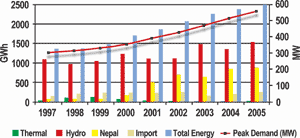 Nepali electricity consumers are about to receive a double blow: a hike in tariff and power cuts.
Nepali electricity consumers are about to receive a double blow: a hike in tariff and power cuts. The last tariff adjustment was in September 2001 and, with creditors scrutinising the financial viability of the national utility, a new hike is overdue. In addition, power demand this winter is all set to outstrip supply. (See also: Editorial, 'Power vacuum', #267)
The national grid has 613MW of installed supply available of which only about 526MW is reliable hydro and the rest thermal. The peak demand in December 2004 was 557MW, just within reliable range which will have increased by seven percent this winter while generation capacity is stagnant.
Nepal's only seasonal storage power is the 92MW from two Kulekhanis, whose reservoir is disastrously low, 11 metres below post-monsoon levels. Poor rains and inept load management allowed energy to spill in other run-of-river plants instead of storing it in Kulekhani.
The only major power project under construction, the 70MW Middle Marsyangdi, is mired in managerial, financial and institutional controversy. When, and if, it is finally completed in 2008 it will handle about two years of load growth. Marsyangdi's 'genetic' institutional defect lies in an open-ended contract with no cap on construction cost so no donor can be found to step in to fill the gap. Some are thinking the unthinkable: are Nepali consumers better off if this project, as currently structured, is scrapped?
There is about 40MW of power under Nepali private construction with fairly reasonable power purchase agreements but they are under various stages of incompletion. While poor financing arrangements are a problem with some, many have shown due diligence but are hampered by an official environment that is neither supportive of their entrepreneurship nor sensitive to the national supply crisis in the offing.
Nepali entrepreneurs, technical manpower and bankers are quite capable of adding up to 25 MW per year but they need a more enabling environment. Chilime shares are over-subscribed, Piluwa is on schedule despite Maoist bombing, a privatised BPC is aggressively scouting new prospects and theft-free community electricity are all successful examples of alternative ways. Even when these success stories are staring us in the face, history is repeating itself and is indicative of a national learning disability.
The proposed across-the-board 10 percent tariff increase is an illustration of such a disability. New power plants, especially ones with seasonal storage, have long gestation periods but there are other immediate measures that can be taken without foreign aid. The restructuring of electricity tariff in May 2003 is an example.
Failure to focus on storage projects after the commissioning of Kulekhani-1 in 1982 resulted in a 'flood-drought syndrome' in the national grid. As things stand, while we will have a shortage of peak power (in MW), there is an excess of energy (GWh) in the system. In 2004 the national system had 2,643 GWh of available energy, but the NEA could sell only 1,964 GWh, essentially spilling close to a third of the system's availability. The situation was much worse in 2003.
Recognising that this spill was the equivalent of almost Rs 5 billion annually, the NEA board made an effort to realise some of it as revenue. It passed a tariff structure that would provide cheap seasonal as well as daily off-peak tariff that would boost sale of the spill energy. For instance, by providing off-peak (10PM-5AM) rates of about Rs 2 per unit for irrigation pumping and electric vehicles and similar rates to domestic consumers and other measures, it estimated adding almost Rs 2 billion annually to its revenue without penalising other consumers with higher tariff.
On the other hand, given low river flow during the dry season in run-of-river plants, there was a need to limit consumption, hence higher dry season tariff. 'Price as police' was better than the bureaucratic fiat of load shedding or conservation jingles in media. These measures were also intended to provide a price signal to Nepali (and foreign) investors to install more expensive storage plants by giving them much better rates for daily and seasonal peak electricity. They would also boost energy industries and encourage them to supply alternatives such as photovoltaics.
Unfortunately, the Tariff Fixation Committee (TFC) failed to appreciate NEA's proposal. If they had only looked at the Khumbu Bijuli Company in Namche, they would have seen how such a tariff structure has doubled KBC's load factor earning it significantly more revenue while saving trees in the Sagarmatha National Park and giving tourism a boost.
The TFC's objections to time-of-day and seasonal restructuring of tariff is based on its inability to distinguish between peak time power shortage and off-peak energy surplus and the fact that in the electricity business demand not met is revenue lost forever.
The TFC also fell victim to media propaganda that the poorest would not benefit from the proposed reduced rates. This charge still doesn't make any sense: to benefit from surplus energy (by replacing LPG cooking gas, for instance) you first have to consume it. Those who pay only Rs 80 a month burning merely four light bulbs don't even use LPG that they can replace.
The net result has been an estimated Rs 6 billion of lost revenue to the NEA (and the country) since 2003. Now a simplistic flat 10 percent increase in tariff is said to be in the offing, which may provide some increased revenue to the NEA but will not do the many other things that a tariff should do to the utility, the overall national electrical industry or the economy.
Dipak Gyawali, Pragya at RONAST, chaired the NEA as Minister of Water Resources in 2002-2003.


